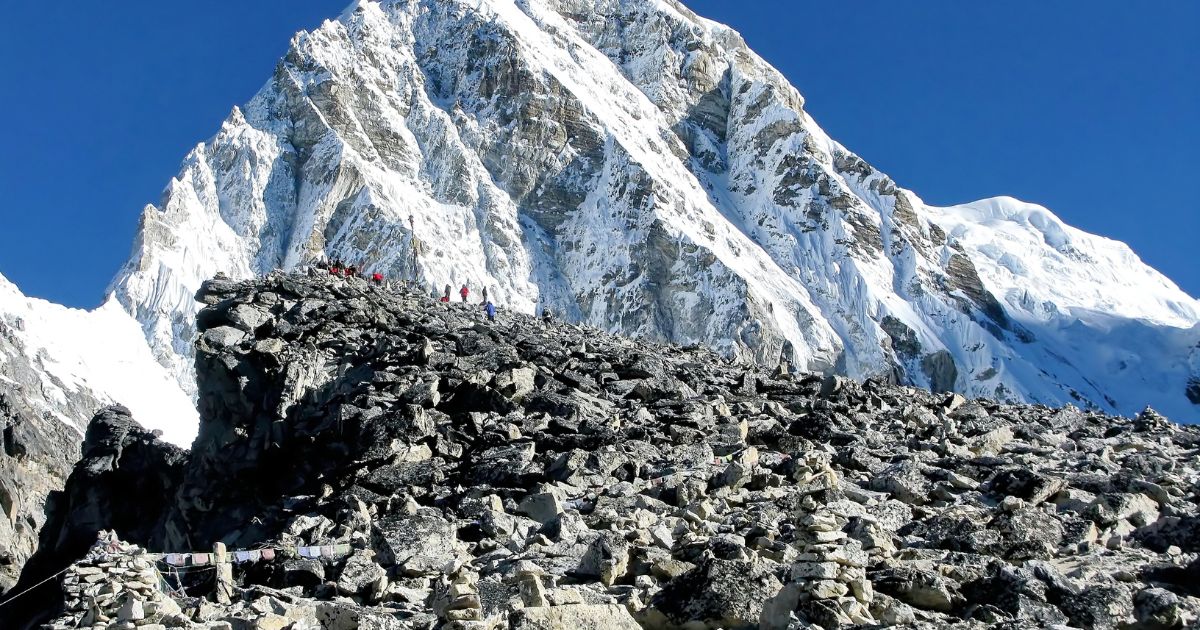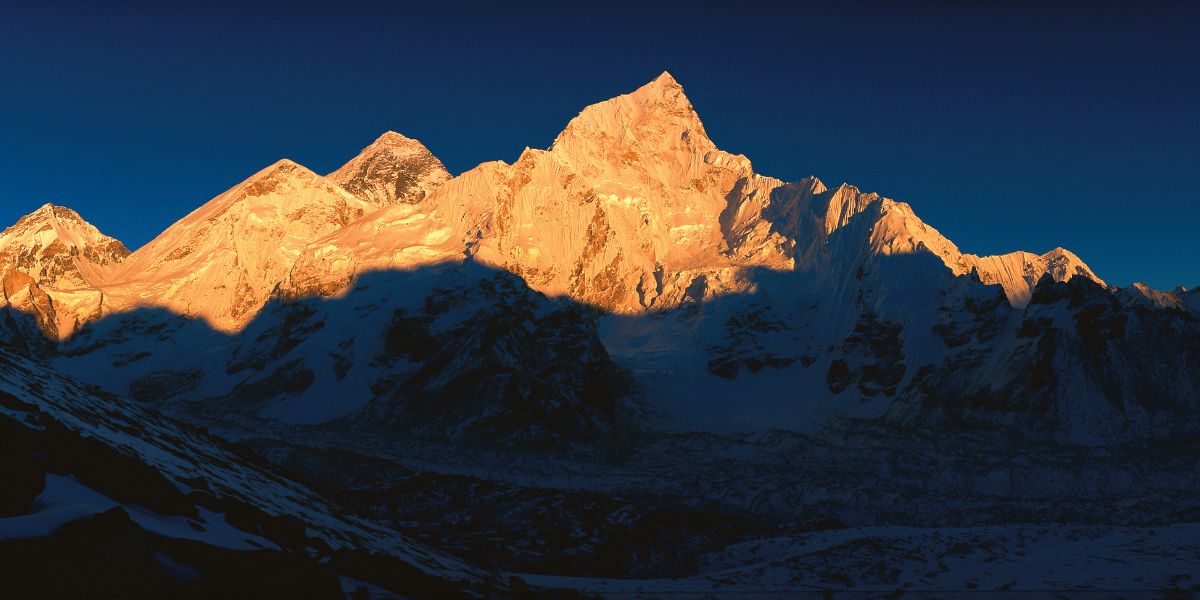
Kala patthar: The viewpoint of Everest

Kala patthar: The viewpoint of Everest
swotah travel
5687
20, 02 2023
Kalapatthar “black rock” gets its name from the colour of it’s rock formation. It is located in the Khumbu region of Nepal and rises to an altitude of 5644 m/ 18519 ft, on Pumori mountain’s south ridge. Kalapatthar is renowned for the clearest and closest view of Everest without any barrier.
It offers the sunrise view that strikes on Everest, and the sunset view from here makes the horizon above look golden. Other giant mountains that can be seen from the Kalapatthar viewpoint are Mt.Lhotse (8516 m /27940 ft), Mt.Nuptse (7861 m / 25791 ft), Mt.Changtse (7543 m / 24747 ft), Mt.Pumori (7161 m/ 23494 ft), etc. It also boasts the magical view of the Mahalangur range.
Kalapatthar is not an actual mountain hence the climb to the viewpoint is moderately difficult and doesn’t require advanced technical skills. The climb up begins from the Gorakshep. From Gorakshep, an ascent that is approximately 1.5 hours to 2 hours long gets us to the top (viewpoint) that flaunts breathtaking panoramic views of mountains and glaciers.
How to get to Kalapatthar?
From Kathmandu, you can take a direct flight to Lukla. There is no proper passable (motorable) path connecting Lukla and Kathmandu. Therefore, driving to Thamdanda/Bupsa through Salleri and then trekking on foot to Lukla is another option. And the last option is to drive to Jiri and by foot trek to Lukla through the traditional route. After reaching Lukla you need to follow the trail of the Everest base camp trek. Through this trail, one will be at Gorakshep. Kalapatthar is just about a 1.5 hours to 2 -hours climb away from Gorakshep so gear up and start scaling.
Or
In case there is not much time to spare or one has any health issues that restrict walking for long period, causing respiratory issues you can go to Kalapatthar by helicopter. This is a perfect option for the older generations and children. A helicopter ride will be a little expensive though. As of today, its cost ranges from $920 to $1000.
What is Kalapatthar famous for?
Besides the astonishing view of Everest and other snow-capped mountains, there are many other fascinations that make Kalapatthar quite famous. Some of them are:
-
The sight of the stunning Khumbu glacier.
-
Chance to experience the warm and colourful culture and traditions of the Sherpas.
-
Tibetan culture, language, and food.
-
Walk through the Sagarmatha national park.
-
Exposure to vivid exotic wildlife and vegetation.
Best time to visit Kalapatthar
It is necessary to pick the right season before leaving for Kalapatthar. One must visit during the right season to see the clear view around with blue skies and warm weather. It protects from a possible encounter with bad climatic conditions. Summer ( June to August ) typically experiences continuous rainfall hence dark clouds. In simple words, these dark clouds and rainfall will block your view and make the climb hard and dangerous.

Photo: Mount Everest view from kala Patthar
Likewise, during winter the temperature drops really low. The lowest temperature can range from -15 degrees Celsius to -17 degrees Celsius. Even during the day, the temperature will be around -1 degree celsius to -5 degree celsius. One sure can visit Kalapatthar in winter but it will be a little harder than in other seasons.
So, when to plan your visit to Kalapatthar?
Well, the early months of the Spring season ( March and April ) and Autumn season ( September, October, and November ) are perfect for the best view and weather that is neither extremely hot nor freezing cold. Around this time the temperature ranges from 20 degrees Celsius to 22 degrees Celsius.
Possible dangers at Kalapatthar
Kalapatthar has an elevation of 5644 m/ 18519 ft which means it has a risk of altitude sickness. With an increasing altitude, you might experience hypothermia, shortness of breath, HAPE, or HACE. Do not let a sunny day fool you for it can transform into a dark, cloudy, and gloomy day in the blink of an eye. It has a high probability of snow storms so make sure you are well prepared and have everything to keep you safe. Even though it is not a proper mountain do not think that conquering the path will be a cakewalk. Be aware of your surrounding, and stay safe from falling rocks, debris, avalanches, and other natural disasters.
Sunrise or Sunset?
Since both the sunrise and sunset views from the top of Kalapatthar make Everest look surreal you might want to know which one to go for. The major factor that should matter is: How is the weather? That is because dark and gloomy days will shield the golden view of Sunrise and Sunset.
The safest option is the sunrise because the weather early morning is usually not foggy so, one gets to witness a golden sunrise view without a doubt. For sunset check, the weather, make sure there are minimal chances of the sky getting cloudy, and gloomy, then soak in the sun setting beside the majestic Everest.

Cultures and Traditions: What to expect?
Kalapatthar is mainly inhabited by humble, kind yet fearless Sherpas. The most followed religion here is Buddhism. Sherpas of this region are influenced by Tibetan culture. The majority of them speak the Tibetan language to this date. Therefore, one will experience warm and humble hospitality while enjoying local’s colourful traditions, cultures, and festivals walking through Kalapathar.
Some ethnic groups do follow other religions and have different customs and beliefs however they all reside here putting their differences aside and embracing each other unique practices.
Also Read: Kyanjin Ri: The Viewpoint of Langtang
Advice
Here are a few pieces of advice so the Kalapatthar will be the experience of a lifetime for you only filled with good memories.
The most important thing is to have enough time dedicated to acclimatization. Acclimatization will help the body adapt to new environmental conditions lowering the chances of mountain sickness. Likewise, stay protected from cold. To keep your body warm make sure you carry enough warm clothes, boots, helmets/hats, gloves, and Polarized lenses or snow goggles. Observe the weather conditions before starting the climb from Gorakshep to avoid environmental hazards.
Be very picky with the food you eat. Stay miles away from oily foods that might hamper your health. Save enough energy right before the climb starts. Wear sun protection to avoid sunburn and keep your skin safe from harmful UV rays. Attempting to ascent alone is not the brightest idea. It is best to have a guide navigate the way to the viewpoint or simply just climb up with a group. Last but not least always carry your first aid kit with you and stay hydrated.
NEWSLETTER SIGNUP
Sign up to receive our trip ideas and travel offers!
Get updates and Exclusive Offers up to 20% Discount








